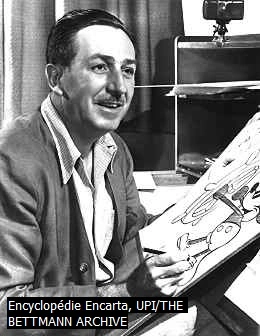Walt Disney.
Publié le 10/05/2013

Extrait du document

Walt Disney. I INTRODUCTION Walt Disney (1901-1966), American cartoon artist and producer of animated films. Disney founded entertainment giant The Walt Disney Company and is considered the father of the animation industry. During his long career he was nominated for 64 Academy Awards and won 26 Oscars, both records. II EARLY LIFE AND WORK Walter Elias Disney was born in Chicago, Illinois. When Disney was a toddler, the family moved to a farm near Marceline, Missouri. He became interested in art at a young age, selling his sketches and drawings to neighbors to earn spending money. During his grammar school years, the family moved to Kansas City. In addition to his regular schoolwork, Disney attended Saturday classes at the Kansas City Art Institute. When Disney was a teenager the family returned to Chicago, where he studied art and photography at McKinley High School and attended night classes at the Chicago Academy of Fine Arts. Disney left high school at the age of 16, hoping to fight in World War I (1914-1918). Too young to enlist in any service, he lied about his age and managed to join the Red Cross. After a short stint as an ambulance driver in France, Disney returned to Kansas City where he met commercial artist Ub Iwerks. Disney and Iwerks started their own business, drawing advertisements and illustrations, then launched an animation studio. The business went bankrupt in the early 1920s, however. In 1923 Disney moved to Hollywood, California. He, his brother Roy O. Disney, and Iwerks began producing short animated films. In 1927 Disney created the cartoon character Oswald the Rabbit. A year later he produced another character, a mouse called Mortimer, but shortly after changed the name to Mickey. In 1928 Mickey Mouse starred in the first cartoon featuring synchronized sound, Steamboat Willie, with Disney providing Mickey's voice. In 1929 Disney began making the Silly Symphony cartoon series, beginning with Skeleton Dance. The studio became a pioneer in color animation with Flowers and Trees (1932), which earned an Academy Award for best short cartoon. III FEATURE FILMS Disney decided to devote the company's resources to producing the first full-length animated feature. In 1937 Snow White and the Seven Dwarfs was released to great acclaim, earning a special Academy Award. The movie was followed by other successful feature-length films, including Fantasia (1940), which combined classical music with animation; Pinocchio (1940), further establishing the Disney pattern of turning classic fairy tales into animated features; and Bambi (1942). The studio also produced films for the United States military during World War II (1939-1945). By the 1950s Walt Disney Productions, Ltd., had become one of the major producers of live-action and animated films for theaters and television. Disney animated features of this period included Peter Pan (1953), Lady and the Tramp (1955), Sleeping Beauty (1959), One Hundred and One Dalmatians (1961), and The Sword in the Stone (1963). The studio also made live-action movies such as Treasure Island (1950), Robin Hood (1951), Old Yeller (1957), The Shaggy Dog (1959), and The Absent-Minded Professor (1961). The film Mary Poppins (1964) innovatively combined live action with animation. Disney television shows of this era included Davy Crockett, The Mickey Mouse Club, and Walt Disney's Wonderful World of Color. IV OTHER VENTURES As the scope of the company's enterprises grew, Disney retained as much artistic control as possible. The company expanded into other areas, such as publishing children's books and comics. Most of these efforts starred familiar Disney characters such as Mickey and Minnie Mouse, Donald Duck, and Pluto the dog. In 1955 the company opened Disneyland, a huge amusement park in Anaheim, California. Featuring historical reconstructions, displays, and rides--many based on characters and themes from Disney films--it became a successful, well-known tourist attraction. The company expanded this concept with Disney World, which opened in 1971 near Orlando, Florida; Tokyo Disneyland, introduced in Japan in 1983; and Euro Disneyland (now Disneyland Paris), debuting in France in 1992. V LEGACY Disney died in 1966. The company he founded, however, has continued to be a leader in animation (including computer animation), live motion pictures, and many other aspects of the entertainment industry. See also The Walt Disney Company. Microsoft ® Encarta ® 2009. © 1993-2008 Microsoft Corporation. All rights reserved.
Liens utiles
- Grand oral du bac : WALT DISNEY
- Disney Walt Dessinateur et producteur de films et dessins animés
- Walt Disney - KUNSTLER.
- Walt Disney
- Peut-on considérer le Roi Lion de Walt Disney comme une réécriture de Hamlet de shakespeare ?































